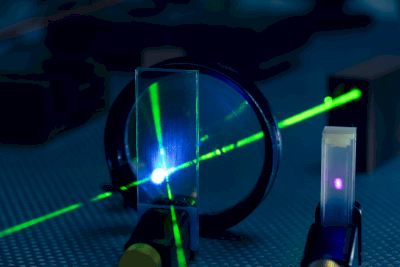What Is a Waveplate?
 A waveplate is an optical element that rotates the polarization plane of incoming light to output light of a different polarization.
A waveplate is an optical element that rotates the polarization plane of incoming light to output light of a different polarization.
Two types of waveplates are commonly used: 1/2 waveplates and 1/4 waveplates. The 1/2 waveplate shifts the phase of light by λ/2 and rotates the polarization plane when the wavelength of light is set to λ (read: lambda). In this case, the outgoing light remains linearly polarized.
A quarter-waveplate can convert linear polarization to circular polarization by shifting the phase by λ/4. Conversely, it is also possible to convert circular polarization to linear polarization.
Applications of Waveplates
Waveplates are frequently used in situations where optical instruments are handled, from academic to industrial applications. Waveplates are particularly useful for changing the direction of laser polarization and adjusting light intensity when using laser equipment.
For example, in processing lasers, quarter-waveplates are used to convert linear polarization into circular polarization, which is applied to cut uniform materials. In academic applications, the polarization plane of a laser can be adjusted with a half-waveplate or similar to gain a more detailed understanding of the dynamics of molecular vibration and dissociation. Control of the polarization direction is important because electronic and vibrational excitations of molecules interact with each other due to electric fields in specific directions.
Conversely, if you do not want to excite in a particular direction, use a quarter-waveplate to convert the light to circular polarization. Waveplates can also be used in devices that arbitrarily control the splitting of lasers; since the angle of linear polarization can be changed with a 1/2 waveplate, it can be combined with a beam splitter that splits the light according to polarization to create a device that can arbitrarily control the intensity of the separated beams.
Since the polarization of the divided beam is at right angles, it is necessary to use two mirrors to change the angle of polarization back, or to use a half-waveplate to change the angle of polarization again.
Principle ofWaveplate
Waveplates have an anisotropic refractive index, which means that the speed of light travels at different speeds depending on the direction of polarization, creating a phase difference. Therefore, it is possible to change the polarization plane of linearly polarized light passing through a waveplate or to make it circularly polarized. To begin with, polarized light is light in which the direction of oscillation in the electric or magnetic field is aligned in a constant direction. Natural light, such as the sun, has a random oscillation direction and is unpolarized, whereas artificially generated light, such as that produced by a laser, can be polarized.
Waveplates are materials that have different refractive indices, depending on the direction of polarization (birefringent materials), such as quartz. In general, the higher the refractive index of light traveling through a medium, the smaller the speed of light. Therefore, light traveling in the direction of the lower refractive index (advance phase axis) propagates through the material more quickly, while light traveling in the direction of the higher refractive index (slow phase axis) slows down.
These properties can be used to create a phase shift between polarization components. If an incident light beam with a certain angle to the advanced phase axis enters a waveplate, the light components (vectors) are decomposed into the advanced phase axis direction and the slow phase axis direction, resulting in a phase shift of the light. As a result, the polarization plane of the outgoing light is rotated.
Other Information on Waveplates
How to Use Waveplates
Waveplates are usually used in a holder whose rotation angle is known. The angle of the waveplate and the polarization angle of the laser beam determine the polarization angle of the laser after it passes through the waveplate. The rotary holder is useful because it allows the laser beam to be set to any desired angle of polarization after passing through it.
The polarization angle after passing through the laser can be calculated from the angle of the waveplate and the polarization angle of the laser. However, to actually check it, the light after passing through the waveplate is passed through a polarizer and the intensity of the light is observed. In this case, it is also possible to check by scattering the light on a piece of paper. However, care must be taken because the paper may burn or the scattered light may damage the eyes even if light-shielding glasses are used in the case of a high-intensity laser.
For a safer and more quantitative method, we recommend using a power meter or similar device to check for the highest intensity at any given angle.